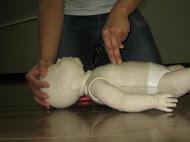
CPR for infants is an important process because it helps rescue babies who may be chocked by toys, food, drowned in a pool or any other emergency that may be life threatening. This is a great measure that you can do to rescue a baby who is unconscious or not breathing. It makes the use of rescue breaths and chest compressions to ensure that blood with a lot of oxygen keep of circulating through the brain and other body parts until the emergency service providers arrive. Keeping the oxygenated blood flowing prevent the brain from any damage which can happen within a very short while. Read this article to understand how you can do CPR for infants.
Determine the Condition of the Infant
The first thing you need to do is to check whether the infant is conscious or not. If you realize that he or she is unconscious its time to call 911 or any other emergency service provider. In case the infant is bleeding, take the necessary measure to stop the bleeding by putting pressure to the area. You should not conduct CPR until the bleeding is controlled.
Open Infant’s Airway
Tilt the infant’s head back using one hand and then lift the chin a bit with the other hand. To open the airway, you do not have to tilt the head so far. Check for any signs of breathing for less than twelve seconds. To determine the breathing in a baby, put the infant’s head next to the mouth. Check whether the chest is rising and listen if you can hear any breathing sounds. In case the infant is breathing, you can determine this on your cheek.
Apply CPR for Infants Rescue Breaths
If the infant cannot breath, you need to give two little breaths for one second each. To give the rescue breaths as you do CPR for infants, cover the infant’s nose and cover the mouth using your mouth. Exhale air into her lungs until you see the infant chest rising. As you give the rescue breaths stop in between, to allow the air flow out. As you move one with the process, remember that the lungs of the infants are smaller than yours, so you need not give a full breath. Breathing so fast or hard can make the air to move into the stomach of the infant. If you realize that the chest is not rising, then note that there is blockage of the airway. This is when you need to offer first aid for choking.
